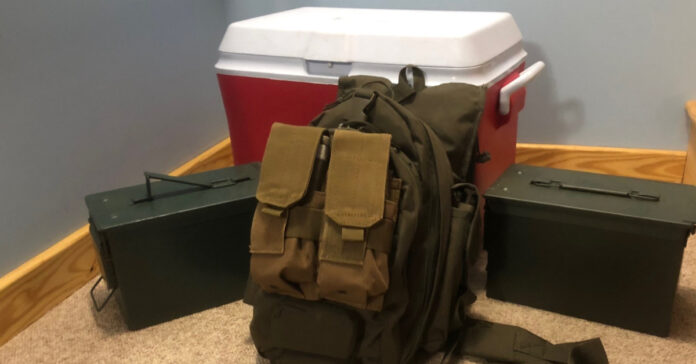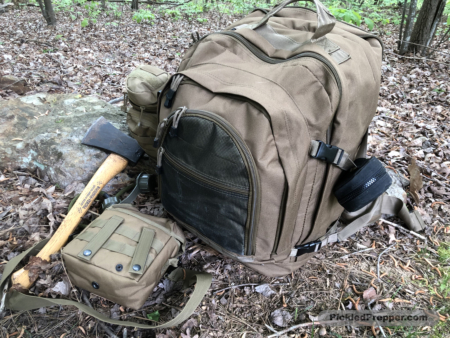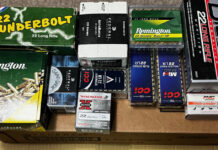
Every time I get into the truck or car, I schlep my every day carry (EDC) backpack from the basement to the vehicle. Lately, I noticed the bag was unusually heavy, so I took the time to go through it, check the contents, and update a couple of things.
As soon as I unzipped it, I found the culprit: a 32-ounce bag of Hershey’s dark chocolate kisses I had purchased for my stash. I had hidden it in my pack so I could carry it into the house without tipping off my wife. Weeks later, it was still in there.
The other two new additions that had added weight were a loaded 5.56 magazine in a sealed zip-lock baggie. No doubt, I put it in there for a purpose, but I don’t recall what it was. I assume it was when I replaced the FAL in my truck with an AR15 in October. I decided to take the magazine out of my bag.
Also new was a multi-tool that had sunk to the bottom of the bag. That amused me because I could not recall where I had put an old Leatherman multi-tool I picked up used. Apparently, I stashed it in there, which makes some sense.
Most of the contents in this bag are high-calorie foods, warm clothing, a full water bottle, water purification tablets, and lots of first aid supplies, covering everything from a snivel kit to tourniquets and Israeli compression bandages. Then there are some common survival items, like fire starters, a knife, flashlight, headlamp, spare batteries, charging cables, etc.
New Addition
You may recall that in June, I updated my carry gun to a Glock 48 with a Holosun 507. Since then, I have burned through three batteries. That means each battery is lasting just over two months.
Why are they going bad so fast? Possibly because I wear the gun more than 16 hours a day and the shake-awake technology means the optic is always on. The dot is also on a bright setting. This version of the optic does not auto adjust the brightness, so I adjust the dot when I am outdoors on a sunny day and leave it there. That means the dot is BRIGHT at night, but I figure this beats trying to remember to turn up the dot every morning and then turn it down after sunset. Finally, these 1632 batteries are much smaller than the 2532s and hold less power.
I took two spare batteries and taped the Holosun tool to them, and stuck the package in a zippered compartment of my EDC bag. If my battery dies on a bad day, I’ll have a couple of spares handy. I would have liked to use the screwdriver on my multi-tool, but one was too small and the other was too big. Oh well, at least the Holosun tool will allow me o adjust the point of aim or even remove the optic, if necessary.
Best of all, the batteries and tiny tool weighed almost nothing at all.
I have learned to tell when the battery is dimming. Yes, it blinks when it is low, but that might only last a couple of days. By looking at the dot regularly, I have learned to tell when it starts to get dimmer and to proactively change the battery. Oh, and I ordered 10 more name brand batteries online.
Checking my Homestead Defense Bag
While I was on a roll, I pulled out my Homestead Defense bag and checked its contents. All good. My biggest problem was I wanted to eat some of the high-calorie food I have in there. I held off.
The next day, I walked the dog through the woods to my first cache site and we checked the cache. It held up well with no apparent water damage. I decided not to check the second cache because it is so far away. Also, I saw no reason to disturb the area which by now should be covered by leaves.
I also grabbed the Coho box from behind the front seat of my truck and carried it inside, where I unlocked it and looked through it. All three 18650 batteries that were inside it were between 3.98 and 4.02 volts, so I stuck them in the charger to top them off (4.20 is the max charge). Otherwise, the kit was fine. There were no surprises in here, and I added nothing to it.
When I put the big container back, I opened the contractor box in the bed and verified that everything looked to be in its proper place. I didn’t take the gear out to examine it because it is a hassle to repack it so that the contents look innocent when opened (as opposed to looking like an armory). In late spring, I will revisit it and function check the weapons.
The Big Bugout Bag
Neither did I open and sort through my bugout bag, mostly because I don’t expect to bug out. Also, because I have lived with that bag for 20 years, I have a solid understanding of what is in it. (Read more about this bag and its contents.)

Given our living situation, I can think of only two things that would make us leave: fire or a mudslide, and I don’t think either one is likely. In a forest fire, chances are, I would stick around to fight it. If the home itself was on fire, there are things I would grab before my bugout bag. I don’t think a mudslide would dislodge us unless it did some severe damage to the house. Given the layout of the land, that’s unlikely.
Nevertheless, I will go through the bugout bag later this year, if only to rotate out the food in it, which will be two years old this summer. I will also look at what is in the two bug-out boxes we maintain. These grab-and-go boxes are loaded with canned foods and dried food like oatmeal. We developed these when we were living in the city and planned to bug out to our retreat. We still have them, but they are less important today and not a big part of our every-day prepping plans. Still, it’s important to rotate food so I doesn’t get too old. We don’t let expiration dates rule our lives, but we do use them as a guide and try to eat our oldest food first.







